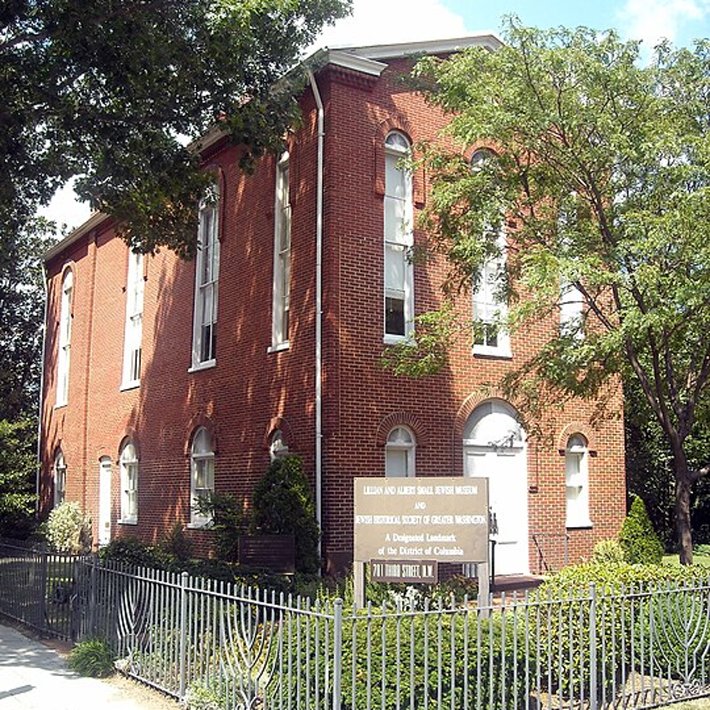In December 1862, Union Major-General Ulysses S. Grant issued General Order No. 11, expelling all Jews from his military district, an area encompassing parts of Tennessee, Mississippi and Kentucky. Several weeks later President Lincoln countermanded the order.
Fourteen years later, President Grant attended the dedication of the new Adas Israel synagogue in the nation’s capital, enduring the sweltering heat for the entire three-hour service out of respect for the city’s Jewish community and its new place of worship—and not leaving before making a generous personal donation.

Grant was the first sitting president to attend a synagogue service there, but not the last. Six days after the assassination of President Kennedy in 1963, the new president, Lyndon Johnson, attended an interfaith memorial service at Adas Israel. The congregation was also the first Jewish house of worship to host a sermon by Dr. Martin Luther King. Other luminaries to attend services or speak at Adas Israel include Presidents Richard Nixon, Gerald Ford and Barack Obama, Vice President Hubert Humphrey, Senator Robert F. Kennedy and Israeli Prime Ministers Golda Meir and Yitzhak Rabin.
And now Adas Israel’s original brick edifice—the oldest synagogue building in Washington, D.C.—has a new role to play, as part of the recently opened 32,500-square-foot Capital Jewish Museum.
The museum houses a collection of more than 24,000 photographs and over 1,000 objects, spanning the history of the Jews in the United States and Washington, D.C., from 1790 to the present—all laid out in exhibition galleries and complete with a terrace affording a view of the Capitol, a lobby atrium and a glass bridge connecting the original Adas Israel building with the new four-story structure.
Of that bridge, Esther Safran Foer, museum board president said, “That bridge, literally and figuratively, connects the past to the present and into the future.”
Carrying that analogy a bit further, Ivy L. Barsky, the museum’s executive director, said the museum also can serve as a bridge to both the secular and religious aspects of Judaism for the observant and non-observant Jew alike.
“We know that a lot of people and a lot of Jews and a lot of young Jewish folks in Washington and elsewhere really connect to their history and heritage in places like ours,” she said. “We’re not about prayer, but I think people get really curious and get answers about Jewishness, to a certain extent Judaism, and museums tend to be really unthreatening, safe places to get that information.”
Visitors to the museum can see a matchbox signed by President Carter that was used at the first lighting of the National Menorah in 1977; a notebook with handwritten words of Louis Brandeis, the first Jewish Supreme Court justice; and the Seder plate used by President Obama’s family while at the White House.
The old merges with the new in the museum: original pews from the old synagogue are on display as well as the door to the mikvah—ritual bath—while one floor up, a multimedia Seder table lends a virtual opportunity for visitors to reflect on current issues including social justice, voting rights and immigration. Why the seder table? Because, as museum curator Sarah Leavitt says, with a chuckle, “that is our other favorite thing to do at the seder table: argue and discuss.”
On that same floor, the tapestry of Jewish life—worship, education, day-to-day life, work, play and cuisine—are spotlighted, along with values at the bedrock of the faith, such as “machloket l’shel shamayim,” or “conflict for the sake of heaven,” and “tikkun olam,” repairing the world.
The priceless nuggets that visitors unearth on exploring the museum, however, are the stories with a human face—like the image of President Grant sitting stoically in the notorious Washington heat and humidity—thanks to the museum.
As Barsky, former CEO of the National Museum of American Jewish History in Philadelphia, said, “I’m a Jewish museum professional for more than 30 years, and I knew very little about the story of Jewish Washington until I got here.”
This blog was contributed by Lew Morningstar.
_______________
From its beginnings, the Church of Scientology has recognized that freedom of religion is a fundamental human right. In a world where conflicts are often traceable to intolerance of others’ religious beliefs and practices, the Church has, for more than 50 years, made the preservation of religious liberty an overriding concern.
The Church publishes this blog to help create a better understanding of the freedom of religion and belief and provide news on religious freedom and issues affecting this freedom around the world.
The Founder of the Scientology religion is L. Ron Hubbard and Mr. David Miscavige is the religion’s ecclesiastical leader.
For more information, visit the Scientology website or Scientology Network.
DOWNLOAD THE WHITEPAPER

